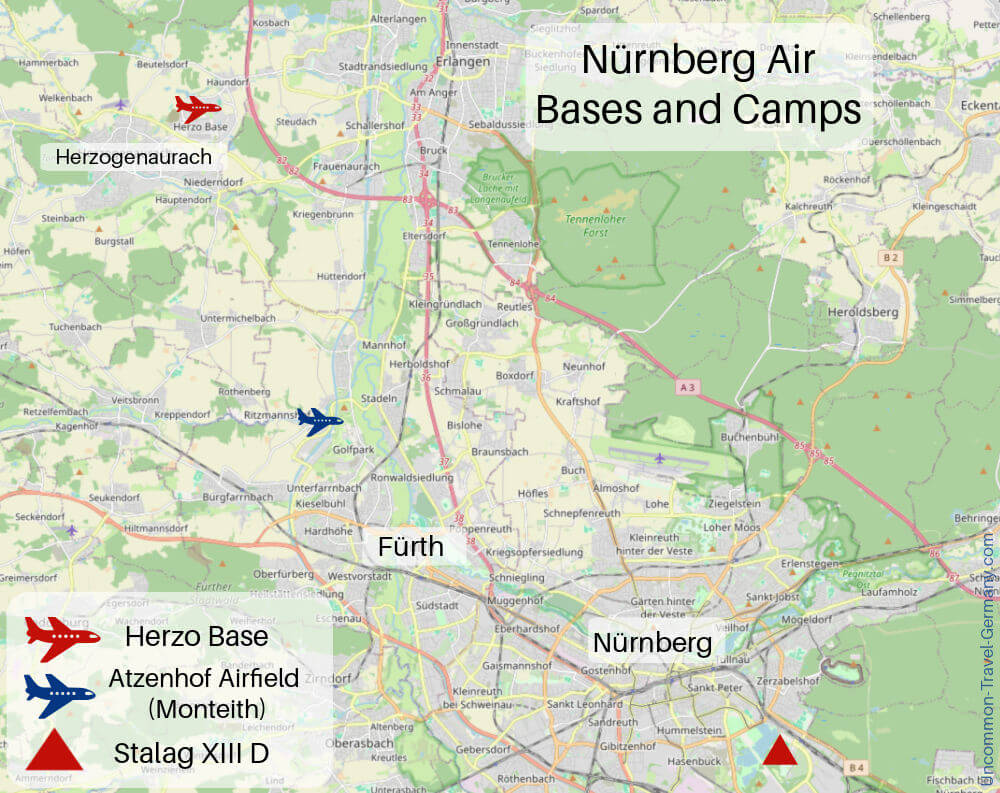- Home
- Hogan's Heroes
- Hogan's Heroes characters
were any Characters in Hogan's heroes based on real people?
There have been suspicions that several of the characters portrayed in the sitcom Hogan's Heroes were inspired by or based on existing individuals.
Let's dig into the mystery!
The prime suspects for being "real":
- Colonel Robert Hogan
- Colonel Wilhelm Klink
- Sergeant Hans Schultz
What's the evidence?
Colonel Robert Hogan
Was Colonel Robert Hogan based on a real person?
There really was a bomber pilot named Robert Hogan who was shot down over Germany in 1945 and held as a prisoner in Stalag XIII D (or actually the officers camp associated with it, called Oflag XIII A or Oflag 73 at different times). Stalag 13D, however, was the one in Nuremberg, not the Stalag 13C in Hammelburg.
Robert Hogan's story is very similar to the fictional Colonel Hogan. As a 2nd Lieutenant in the Army Air Force, he started flying combat missions from a base in Italy in November of 1944. His group was bombing bridges, troops and oil refineries in Austria, Italy and Yugoslavia.
His plane was shot down during a mission over Yugoslavia on January 19, 1945. He was captured and sent to the officers' camp associated with Stalag XIII D in Nuremberg.
His son contacted me and told me of several similarities with the fictional Stalag 13:
- The camp commandant wore a monocle like Colonel Klink.
- The barracks sergeant was fat and jovial like Sergeant Schulz.
- The prisoners had a secret radio for news that the commandant allowed to operate.
Was Lt. Robert Hogan the model for Colonel Robert Hogan in the series?
Apparently not. According to Bernard Fein, one of the creators of the show, he named the character after a friend of his, another Robert Hogan (who actually appears in two of the episodes in small roles). Also, Lt. Robert Hogan, later Dr. Robert Hogan, was never in contact with the show's producers until after Hogan's Heroes had been running for awhile.
For more info on Dr. Robert Hogan's connection to the show, see my Hogan's Heroes' article.
Colonel Wilhelm Klink...or was it Klenk?
Was there a real POW camp commandant named Colonel Klink?
Unknown, as of yet. But there was a German officer with almost the same name who commanded a Luftwaffe base very near Stalag 13D.
This evidence was shared with me by Dr. John Caruso, who had a personal experience with some of the people involved.
During the 60s and early 70s, Dr. Caruso was a lieutenant in the U.S. Army, serving as a liaison officer between the German community and the Americans occupying the former Luftwaffe base at Herzogenaurbach, near Nuremberg. The base (called Herzo Base) was being used by the Army Security Agency to monitor communications intercepted from the communist-controlled areas of central Europe.
One day in late 1964, a Frau Klenk came to speak to the commanding officer of Herzo Base and Lieutenant Caruso explained her request to the LTC. It appeared that her husband, a Colonel Ernst Klenk, had been the commandant of the Luftwaffe base located there. Apparently the furniture in the current commandant's office had belonged to her family and had been installed there while her husband was using the same office during the war.
There was a Biedermeier desk that she particularly wanted returned as it was a family heirloom, along with some other furniture in the office. Unfortunately, the LTC had a strong dislike of Germans and was quite rude to Frau Klenk. She didn't get the furniture returned.
Dr. Caruso found records of a Colonel Ernst Klenk listed as the commander of the Herzogenaurach Luftwaffe base from 1939 to August 19, 1942. (See Luftwaffe airfields pdf under Herzogenaurach.)
Herzo Base had been used by the Luftwaffe starting in 1934 to train fighter pilots, and from 1939 to 1945, fighter wings were stationed there.
American soldiers took over the base in April of 1945, and the facility was returned to the German government in 1992.
An actual photo of the original "klink"?
 Colonel Ernst Klenk, Commandant at Herzogenaurbach Airbase, on far right
Colonel Ernst Klenk, Commandant at Herzogenaurbach Airbase, on far rightDr. Caruso got the above photo from one of the barbers at Herzo Base, who had served in the Luftwaffe under Klenk when he was a major, later a colonel. The barber, Willy, pointed out Klenk in the photo.
It was probably taken at the Altzenhof airbase (later called Monteith Barracks by the Americans). This was a smaller airfield a few kilometers from Herzo Base where Klenk was stationed.
Did Colonel Klenk command a stalag 13?
So far, there is no evidence that he did.
But he could have. One of the four Stalag 13s, Stalag XIII D, was located just 35 kilometers from the airbase in Herzogenaurach where Colonel Klenk was stationed until 1942. Stalag 13D had been built on the grounds where the Nazi Party rallies were held in Nuremberg before the war.
Stalag 13D was closed in August of 1940, and the POWs there were distributed amongst the three new camps, Stalag 13A (Sulzbach/Rosenberg), Stalag 13B (Weiden), and Stalag 13C (Hammelburg).
But the camp (called Stalag XIII D, Nürnberg/Langwasser) was reopened in April of 1943, and later received a huge influx of POWs in late 1944. The prisoners were being moved west as the Russian troops were advancing. The last commandant of the camp was a Colonel Pellet, but I still don't know who the commandants were from 1943 until Colonel Pellet took command at some unknown date.
We do know Colonel Klenk wasn't at Stalag 13C in Hammelburg. The three Stalag XIII C commandants during the war years were Lieutenant Colonel von Crailsheim, Colonel Franck and Colonel Westmann.
What was Colonel Klenk doing after 1942? We don't know.
2nd Lt. Robert Hogan was in the camp from January 1945 until it was liberated on April 16, 1945. He said the commandant wore a monocle, but didn't mention his name.

Stalag 13C in Hammelburg was about 150 km from Stalag 13D in Nuremberg.

District XIII was Nuremberg. There were four Stalag 13s during WW2:
- A- Sulzbach-Rosenberg
- B- Weiden in der Oberpfalz
- C- Hammelburg
- D- Nürnberg/Langwasser.
 The four Stalag XIIIs
The four Stalag XIIIsSergeant hans Schulz
Was there a real Sergeant Schulz at Stalag 13? Probably not, at least there's no evidence so far that there was.
However, there was a rotund, jovial barracks sergeant at Stalag 13 D in Nuremeberg when Lt. Robert Hogan was a POW there. Hogan didn't mention his name, and the character of Schultz was created before Dr. Hogan contacted the show's producers, so they apparently didn't get the idea from him. But could they have gotten that information from other former prisoners at the camp?
Richard Powell, one of the scriptwriters for the show, said he created the character of Sergeant Schulz when he rewrote the pilot episode. The original script submitted by the producers Bernard Fein and Albert Ruddy didn't have the Schultz character.
But there's another possible source. The film Stalag 17 (based on the Stalag 17 play), about POWs in a camp in Germany, had a Sergeant Schulz as the barracks sergeant. He was friendly, joked around with the prisoners, and had a stocky build like the other fictional Schultz. This and other similarities between Stalag 17 and Stalag 13 in Hogan's Heroes led to a lawsuit for copyright violation against the studio producing the sitcom in 1967.
The jury found the similarities were significant enough to conclude Hogan's Heroes had copied Stalag 17, but the judge reversed the verdict, saying there was insufficient evidence of plagiarism to support the jury's finding. The judge emphasized that Stalag 17 was a serious film, albeit with some humorous elements, while Hogan's Heroes was strictly a comedy.
Here's the actual judge's decision in the Hogan's Heroes lawsuit, delivered in 1971.
Powell claimed he had never seen the film Stalag 17, which came out in 1953, or read the play, when he created Sergeant Schulz.
Sergeant Schultz in stalag 17
If you like Hogan's Heroes, it's fun to watch the Stalag 17 film to find the similarities (and also because it's a good film). Some of parallels: the very similar barracks sergeant, Sergeant Schulz, (and both even named Johann or Hans) of course, but also the camp commandant, who actually says "no one has ever escaped from Stalag 17".
Weirdly, the camp commandant in Stalag 17 (played by Otto Preminger) sounds exactly like General Burkhalter in Hogan's Heroes, down to the identical accent and delivery!
Plus, the plot of Stalag 17 revolves around trying to discover the identity of the spy among the prisoners who is informing on their escape plans. The first episode in Hogan's Heroes also involves a prisoner who is spying for the Germans: Episode 1-The Informer.
I couldn't find a streaming version of Stalag 17, but it's available from Amazon and on YouTube.
William Holden won an Oscar for best actor at the Academy Awards in 1954 for his performance in Stalag 17.
"No one has ever escaped..."
Could it have been a coincidence that this line was used in both the film and TV series? Especially since it was one of Colonel Klink's favorite lines!
A great source for all things Hogan's Heroes is Brenda Scott Royce's book, Hogan's Heroes: Behind the Scenes at Stalag 13.
This book is a goldmine of information on the creation of the show, as well as the actors and episodes, published in 1998. The author was able to interview many of the writers, actors, producers, and family members while they were still alive and has a ton of original background content on the show. Some of the above information in this article comes from her book.
Hogan's Heroes: Behind the Scenes is available on Amazon.
The Behind the Scenes book is out of print now, but there's a Kindle version, and occasionally used paperback versions are available on Amazon. Werner Klemperer wrote the forward for the book.
I may earn a small commission if you make a purchase through some of the affiliate links on this page. See disclosure policy. This helps me provide all the free information on the site. Thank you!
Was Hogan's Heroes inspired by another tv show?
Brenda Royce in her book describes another source for the idea of setting a sitcom in a POW camp.
The creators of Hogan's Heroes (Fein and Ruddy) originally tried to pitch a comedy script about prisoners in a minimum security prison who had an escape operation going on under the nose of the warden. They couldn't get anyone to buy it, but then they heard about another sitcom in the works at a competing studio. This was the show Campo 44 about prisoners in an Italian POW camp. Ruddy said this gave them the idea to switch their script over to a German POW camp setting.
Hogan's Heroes started running before Campo 44, and many thought Campo 44 was copied from Hogan's Heroes. Ironically, one of the actors in Campo 44 was Vito Scotti, who would later guest star on Hogan's Heroes as the Italian camp commandant, Major Bonacelli.
More Stalag 13 info:
- The history of Stalag 13C (Hammelburg)
- What's at the camp now - Stalag 13 today
- The real Hammelburg
- More on Hogan's Heroes
- The other Stalag 13 - Stalag 13B (Weiden)
Share this page:

